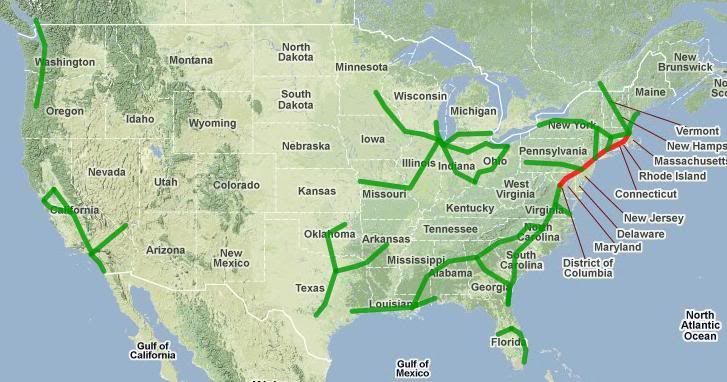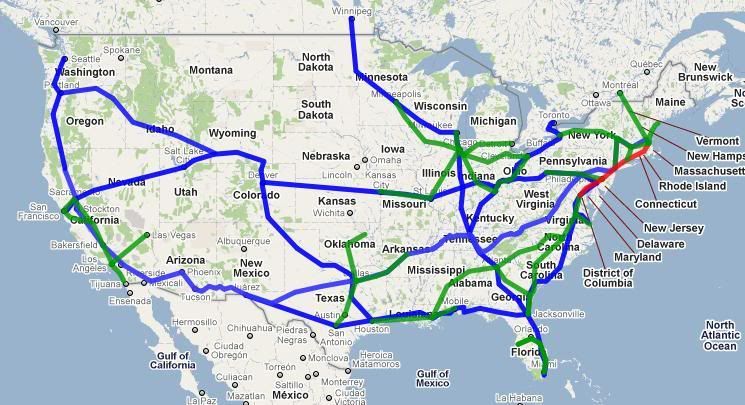(11 am. – promoted by ek hornbeck)
Burning the Midnight Oil for Living Energy Independence
 Way back before the Super Bowl, the White House had a series of exciting announcements, covered at The Transport Politic under the heading The White House Stakes Its Political Capital on a Massive Intercity Rail Plan.
Way back before the Super Bowl, the White House had a series of exciting announcements, covered at The Transport Politic under the heading The White House Stakes Its Political Capital on a Massive Intercity Rail Plan.
That article is accompanied by the map reproduced here ~ and I stress that the map if Yonah Freemark’s work, not a map presented by the White House ~ of what a HSR system that rises to the “80% of Americans” target would look like.
And one reaction to that map is the same as the reaction to the designated DoT HSR corridors: how is that a national network? Its just bits and pieces.
How to fix this image problem, while also providing a substantial upgrade to the program, below the fold.
This is a familiar problem
 The problem is even worse when people go to the Department of Transport website and take a look at the “designated HSR corridors”. Since this is an issue that comes up almost every time I post that picture, its an image problem I am used to addressing.
The problem is even worse when people go to the Department of Transport website and take a look at the “designated HSR corridors”. Since this is an issue that comes up almost every time I post that picture, its an image problem I am used to addressing.
First, this is not a network plan, its a map of those corridors that have successfully jumped through all the hurdles to be eligible for HSR grant funding. Indeed, the reason the NEC (Northeast Corridor) is in Red instead of Green is that it has not been taken through those hurdles ~ instead its been receiving funding dedicated to Amtrak, rather than competing for what were miniscule amounts of HSR funding before the Stimulus Bill and its big bang $8b in funding.
Now that the White House has proposed basically $8b per year, split between dedicated funding to building new higher speed transport services and funding to upgrade and improve existing rail infrastructure ~ it seems reasonable that its time for the NEC to get designated. Maybe it could be split between existing corridors ~ DC to Phillie into the Southeast HSR corridors, Phillie to NYC into the Keystone Corridor, NYC to Boston into the New England HSR corridors.
Second, the target for either Rapid Passenger Rail, Regional HSR or Express HSR are trips of 500 miles or less ~ while the details depend on the efficiency of the alignment:
- Roughly 100 to 300 miles for Rapid Passenger Rail, with maximum speeds of 110mph and transit speeds at or slightly better than Interstate Highway transit speeds
- Roughly 100 to 400 miles for Regional HSR, with maximum speeds of 125mph, typically electrified on dedicated passenger track, but able to share existing rail right of way
- Roughly 100 to 500 miles for Express HSR, with speeds over 125mph and maximum speeds of 220mph or more, requiring its own dedicated and all grade separated right of way
When you connect the metropolitan areas with populations to justify the investment required for Regional HSR and Express HSR, you simply do not necessarily get a coast to coast system,
So even if that “officially designated” system is bulked up by adding (1) the most promising corridors that the states have not gotten around to designating, such as Houston / Dallas, Pittsburgh / Cleveland, Detroit / Cleveland, Orlando / Jacksonville and etcetera and (2) existing state plans that build up from the “foundation” corridors that it makes sense to designate first … there will still be those gaps.
An Entirely Different National High Speed Rail network
 Sunday Train readers will recognize this map, which presents proposed Steel Interstate corridors.
Sunday Train readers will recognize this map, which presents proposed Steel Interstate corridors.
Steel Interstates are, primarily, High Speed FREIGHT Rail. They are intended to be electric rail corridors. They are to be provided with Positive Train Control throughout so that they can allow Rapid Freight Rail ~ 100mph single stack container trains, operated to schedule, to be able to offer faster and more reliable loading dock to loading dock times even with most containers having a short haul truck trip at both ends of the trip.
“Able to offer” is a key here ~ in curvy sections of right of way, there would be express track that would be elevated for Express freight, but with 3 inches of “unbalanced” cant allowed, that could in many cases also accommodate heavier (for example, double stack container) 60mph freight trains as well.
Much less annual funding is required per mile of Steel Interstate, since the funding is providing an interest subsidy, with the capital cost repaid by the access and user fees paid by trains using the new infrastructure ~ whether passing track or dedicated track, trains using the publicly owned express infrastructure would pay an access fee, and all trains using the publicly owned overhead electric wires would pay a user fee.
On reflection, that isn’t entirely different High Speed Rail after all
Now, from the perspective of passenger trains, if there is dedicated express track alongside the conventional heavy rail track … this is a 125mph Regional HSR corridor. It is, certainly, one that is used by and primarily paid for by freight services: but if Rapid Electric Freight can run on it at 100mph, then with suitable upgrades to level crossings, electric passenger tilt trains can run on it at 125mph.
If this is Express passing track added to conventional heavy rail track … this is a 110mph Rapid Passenger Rail corridor. Again, one primarily used and primarily paid for by freight services, but Rapid Passenger Rail nonetheless. To accommodate 100mph freight, the level crossings already have to be upgraded to Rapid Passenger Rail standard.
Except this is Rapid Passenger Rail and Regional HSR on an “Amtrak Dream” model, since this is publicly owned infrastructure designed to allow freight rail to keep to a schedule, which means, at the same time, it is designed to allow passenger rail to keep to a schedule. Buy the appropriate 110mph or 125mph trains, pay the access and user fees, and run the train.
The higher speed means that crew costs are lower per mile. The higher speed means that demand for the trips is stronger. And the higher speed means its possible to make more trips with the same trains, so the new trains serve more miles per day than the current Amtrak trains can do. And the design for path reliability ~ a design requirement for the freight market being targeted ~ means that there are fewer delays and it is possible to trim the slack that has to be built into current Amtrak schedules, while still meeting better on time service targets.
And Look What Happens when the Steel Interstate is added
 Nowl, assume that there is passenger service ~ twice a day, three times a day, eight times a day … whatever the market will support ~ along the Steel Interstates. (original jpg)
Nowl, assume that there is passenger service ~ twice a day, three times a day, eight times a day … whatever the market will support ~ along the Steel Interstates. (original jpg)
NOW we got a national network.
Now, remember the $8b/yr? If we are willing to have a little patience in how rapidly we roll out the Steel Interstates, and finish them in something more like sixteen years than the six years that would be required at full commercial urgency, $2b in interest subsidy annually until the system is completed and the capital entirely refunded would be sufficient.
That suggests:
- $4b annually for new Regional and Express HSR passenger rail track and, where required, corridors, on an 80:20 Federal:State match basis
- $2b annually for the Steel Interstates, $500m to each Line Development Bank, leveraging a capital base of about $10b (or more) each, with user and access fees for use of completed infrastructure rolled over into further work until the designated Steel Interstate is completed.
- $2b for Rapid Passenger Rail, complementary conventional passenger rail, common rail infrastructure improvement projects, and operating funding for launching preliminary services
Midnight Oil ~ Truganini

1 comments
Author
… I’m going to pretend it was early.
Another Sunday Train will be rolling in, in another day or two.